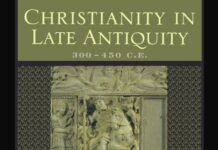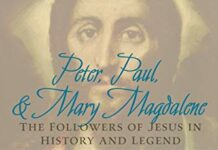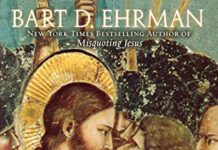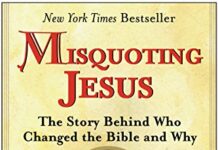
Ebook Info
- Published: 2005
- Number of pages: 312 pages
- Format: PDF
- File Size: 4.73 MB
- Authors: Bart D. Ehrman
Description
The early Christian Church was a chaos of contending beliefs. Some groups of Christians claimed that there was not one God but two or twelve or thirty. Some believed that the world had not been created by God but by a lesser, ignorant deity. Certain sects maintained that Jesus was human but not divine, while others said he was divine but not human.In Lost Christianities, Bart D. Ehrman offers a fascinating look at these early forms of Christianity and shows how they came to be suppressed, reformed, or forgotten. All of these groups insisted that they upheld the teachings of Jesus and his apostles, and they all possessed writings that bore out their claims, books reputedly produced by Jesus’s own followers. Modern archaeological work has recovered a number of key texts, and as Ehrman shows, these spectacular discoveries reveal religious diversity that says much about the ways in which history gets written by the winners. Ehrman’s discussion ranges from considerations of various “lost scriptures”–including forged gospels supposedly written by Simon Peter, Jesus’s closest disciple, and Judas Thomas, Jesus’s alleged twin brother–to the disparate beliefs of such groups as the Jewish-Christian Ebionites, the anti-Jewish Marcionites, and various “Gnostic” sects. Ehrman examines in depth the battles that raged between “proto-orthodox Christians”–those who eventually compiled the canonical books of the New Testament and standardized Christian belief–and the groups they denounced as heretics and ultimately overcame.Scrupulously researched and lucidly written, Lost Christianities is an eye-opening account of politics, power, and the clash of ideas among Christians in the decades before one group came to see its views prevail.
User’s Reviews
Reviews from Amazon users which were colected at the time this book was published on the website:
⭐The book was content-heavy. Not a difficult read, but I did need more breaks than when I read a couple of other Ehrman’s books, such as, Misquoting Jesus and How Jesus Became God. Sometimes books have what I call, “filler” in them that take up your time but have no meaningful content. This book had no “filler”. It was jam-packed with information about the different sects of Christianity–Ebionites, Marcionites, Gnostics, etc… It explained what each Church Father believed was the “right” way to view Jesus’ divinity and what each one of them considered heretical. The pacing of the book was steady and maintained my interest all the way to the end. Excellent book.
⭐Excellent overview of the early Cristianities—proto-orthodox and its many heretical cousins.I’ve read 10+ Ehrman books, another 10+ historical/critical bible studies and dozens of pieces of atheist literature. I think those reads assisted me in fully enjoying and understanding this book; my previous reading experiences “greased the rails” for this book. Perhaps you won’t need that assist, but I’m glad I had it.Again, this is MANDATORY reading for a person who wants the true story, rather than faith’s cockeyed version.Ehrman doesn’t say it, but he certainly suggests that the following idea is true: Today, no one practices the religion practiced by Jesus, and Jesus never practiced any of the religions practiced today. Christians today are generally clueless regards their roots, but through no fault of Ehrman’s. He cannot force people to read well-researched and authoritative texts.Score another point for Ehrman on the playing field of religious research geared toward the common man.Please write another, while I track down the dozen-or-so Ehrman books I’ve yet to read.Thank you, Bart.
⭐I saw this book recommended by Matt Dillahunty of The Atheist Experience. It’s a well written book, unbiased and doesn’t come across as trying to undermine Christianity. Instead, it gives voice to early Christian groups that were sincere and trying to understand Jesus’ messageb but who had very different interpretations than the group that formed the new testament.I’m no longer Christian, and the book helped me to see the early Christian groups in a more understanding and positive light , as they sincerely looked to grasp and interpret the teachings associated with Jesus. I found it very helpful to see that the interpretations and theology that’s in the new testament are just one group’s take on things. Other sincere (and very sizable) early Christian groups had very different interpretations based on the same teachings from Jesus. These groups were reframed by the group that won as small in size and representing some wild, heretical perspective; this book corrects this and shows the truth. Interestingly, I thought of how my rejection of what’s in the new testament may very well be rejection of a specific group’s misinterpretation of Jesus & that I could find alignment with other early Christian groups. It also served to resolve a question of mine with respect to the historicity of Jesus (so many different and sincere groups with different interpretations and their own Scriptures make me fall squarely on the view that Jesus was a historical figure).
⭐For any one interested in the history, authenticity of the New Testament books, this is a must reading. The author successfully makes the reading interesting and, more importantly, very readable. There are occasions of repetitiveness but aside from that I highly recommend the book but it needs to be approached with a great deal of openness and an absolute lack of religious bias. This is not a book for the dogmatically religious person for whom any writing that deviates from a perceived perspective is, a priori, false and inaccurate. The author gave me a wonderful sense of the inner conflicts and dynamics that early Christianity had to endure before becoming the standard and established religious dogma. It also gives an invaluable perspective on the various prejudices and struggles that religious leaders had to encounter in order to retain their views of historical truths as they interpreted the existing documents at the time. I personally could not put the down and was enthralled by it. Highly recommended.
⭐This book is a really fun read. There is a ton of info, but Ehrman does repeat bits and pieces until it becomes familiar to the reader. Like his other books, it’s also divided up into short segments, so it’s easy to take breaks. He writes in a casual way, which I enjoyed. I would recommend this to anyone who likes religious studies, history, theology, so on and so forth.
⭐If you’re curious about early forms of Christianity and how the proto-orthodox form triumphed, this book is for you. Ehrman covers the Gnostics, Marcionites, and Ebbionites quite thoroughly and mentions other less popular forms. Even if you have no prior knowledge about the subject, you won’t be overwhelmed. The book is written in a clear, easy-to-read style and includes intriguing details about the early Christian churches. It’s a fascinating read.
⭐A very deep and about as objective view as one might be able to get about the many sects of Christianity that existed before what we now consider to be orthodoxy became dominant. Ehrman takes a no holds barred approach to his research and analysis of what diversity there was between the Passion of Christ and the suppression of whatever practices there were before orthodoxy became the dominant form of Christianity. A graduate level reading, not for the faint of heart with respect to faith and theology. The information therein is likely to be considered fake news by the evangelical right.
⭐For any who have the need to look beyond the ‘scripture’ of the Judio-Christian Ethic, this book is a Great start. For a Bible Scholar, or for anyone with a Quest For Knowledge, again, this book is a Great start. Decide for yourself. The Truth Is Out There…
⭐Although not a theist in any manner of speaking, I have an extensive library of books on various religions and sects. This book was an Amazon recommendation based on my purchasing history and was one of the most interesting and informative books that I have ever read. Needless to say, it supported and confirmed many of the things I already knew but in addition, it gave thoughts and explanations on many of the facets of Christianity that had been a bit muddy in my mind. One of the interesting speculations contained in this book is what the effect on the world of different “winners” amongst the many and varied interpretations by the plethora of Christian sects in the first few centuries might have been. It has taken me a number of days to read this book, not because it is a difficult read – far from it – but because it has been so thought-provoking and necessitated further corroboration from elsewhere in my library and occasionally, reference to my Oxford dictionary. A truly exceptional book!
⭐This book takes a broad look at the “canon” of the New Testament (i.e. the process whereby books were gradually and then finally established by the 5th Century as the ones to be included therein) and forms a study of the works that were left out and the various early Christian sects that supported them.His research details an early Christian world of confusion, with the words of the disciples who were with Jesus, and the apostles who preached and wrote about him, being taken and subjectively interpreted by a multitude of contemporary groups. As well as disparate beliefs on how much of their indigenous Jewish heritage, beliefs and practices these new Christians should retain, many groups were also influenced by things like Gnosticism and existing contemporary Greek thinking and philosophy, such as that of the neo-Pythagoreans and the Stoics.Thus, while we are yet to have “Christians” – a word not yet in use at the time of many of these groups – we are introduced to the Nazareans, Carpocratians, Docetics, Ebionites, Marcosians, Marcionites, Montanists, various types of Gnostics and those with the set of beliefs that the author terms “proto-Orthodoxy” which eventually evolved to become Roman Catholicism.Many of these groups used the gospels that were available to them, and many of these have either not survived at all, or not survived as part of the modern Christian canon, only being rediscovered with archaeological finds hundreds of years later, such as the Nag Hammadi scrolls.Many of the Christian sects and groups used the names of Jesus’ disciples or the apostles as the author of their texts in order that they might get a wider circulation – technically a forgery – while still being genuine texts of that particular Christian sect. In other cases the author gives examples of clear forgeries – for example the senior churchman who was caught red-handed writing a third book of Corinthians, and was disciplined henceforth.The sheer variety of beliefs in early Christianity is fascinating, though given the circumstances it’s easy to see how a Jewish teacher such as Jesus provides new teachings to his Jewish followers, and after his death there spring up so many groups believing slightly different things about what he meant by his teachings and what his death meant. With only the Old Testament to go by as their holy book there were various opinions on whether Jesus was the Messiah or not, and if so what type; whether his followers were now a new religion that no longer needed to practice circumcision, and could they now eat pork? Was Jesus God as well as his Son? – and all the questions pertaining to the mystery of the concept of Father Son and Holy Spirit, long before a standard concept of the Holy Trinity had been established, and so on.A very enjoyable read and a fascinating insight into the beliefs of the early Christians before the Church finally decided what should and shouldn’t be kept out of the New Testament (various early regional churches had their own canon processes and as a result many ended up with different texts altogether in their New Testaments, ranging from 11 to 22 books); and before the religion became “regulated” into one coherent belief system, the others being subsumed and vanishing into history.
⭐This was a well-written and thoroughly enjoyable review of very early Christianities. The plural is Ehrman’s own use: and essential to the theme of the book, in which he describes in great detail the extraordinary divergence of early Christian movements, showing how what is now orthodoxy won out amongst a range of views. Obviously the majority of the sources are those tracts, such as Irenaeus and Tertullian, who condemn the losing forms (now considered “heretical,” but Ehrman’s point here is that the weren’t heresies in the modern sense because there was no orthodoxy against which to measure themselves) and the Nag Hammadi library, but I was surprised by how much can also be eked out by close (and impartial) reading of the accepted canon.Best read in conjunction with his Lost Scriptures book which provides readable translations of those now non-canonical books which have been preserved (thus making it the most in accurately named volume imaginable).
⭐A great research book, for putting the past into what really happened and not what man thinks that happened as we are very mislead these days by many things. What is written is not necessarily correct.. You have to read and find out for yourself.
⭐The constant assertion that these were actually viable and genuinely ‘Christianities’ is a bit much.
Keywords
Free Download Lost Christianities: The Battles for Scripture and the Faiths We Never Knew in PDF format
Lost Christianities: The Battles for Scripture and the Faiths We Never Knew PDF Free Download
Download Lost Christianities: The Battles for Scripture and the Faiths We Never Knew 2005 PDF Free
Lost Christianities: The Battles for Scripture and the Faiths We Never Knew 2005 PDF Free Download
Download Lost Christianities: The Battles for Scripture and the Faiths We Never Knew PDF
Free Download Ebook Lost Christianities: The Battles for Scripture and the Faiths We Never Knew





